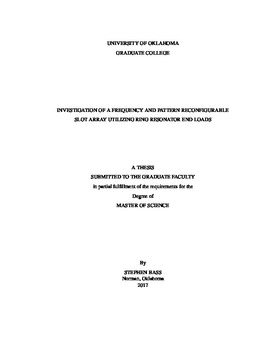| dc.description.abstract | Fixed-bandwidth wireless systems are forced to operate in preallocated blocks of frequencies, often wasting valuable spectrum. Whereas, systems with reconfigurable antennas that can tune resonant frequency, polarization, or pattern allow for versatile systems and efficient spectrum use. Reconfigurable antennas have largely been designed using microstrip transmission line structures since they can be easily printed on a dielectric substrate, making the antenna compact, inexpensive to fabricate, and simple to integrate active components in a series configuration. Slotline is similarly easy to fabricate and has been shown to have some advantages over microstrip in applications such as when active components in a shunt configuration are desired. However, not many reconfigurable antenna architectures have been developed in slotline. Additionally, while frequency- and polarization-agile antennas have been reported by many researchers, antennas with both frequency and pattern reconfiguration capabilities are significantly rare.
In this thesis, a closed-form analytical solution for a Yagi-Uda array of loaded slot antennas will be presented. This analysis first evaluates each slot antenna using an established transmission line model then calculates the coupling between the elements using the relative induced power on each antenna. Network parameters are then utilized to model the effects the slot antennas have on each other. The Induced EMF method uses the power incident on one antenna due to another to find the mutual impedance between them - allowing the presented method to be generalizable to any Yagi-Uda array of elements where the radiation pattern is known. The network parameters will be shown to provide an array factor for the Yagi-Uda array - predicting the radiative and directive properties of the array in a closed-form analysis. The analysis method will also be shown to predict the input impedance of the driven element of the array, including the impact of mutual coupling from the parasitic elements, across frequency and for arbitrary array spacings - a result that has not been available with previous analysis methods. | en_US |
